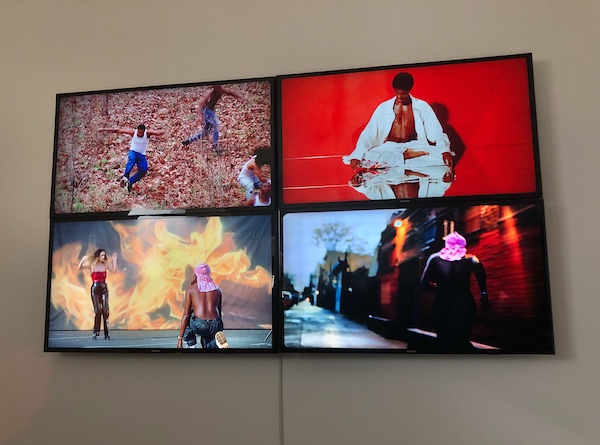After a slight summer slumber, the LA art scene has officially turned the heat back on. This week I had the absolute pleasure of spending my Thursday morning in the LA Arts District at Hauser & Wirth for their press preview and breakfast featuring the work of Philip Guston and Charles Gaines. I was delighted to spend my time in the beautiful exhibition space, fully immersing myself in both artists’ work while gaining some new insights along the way.
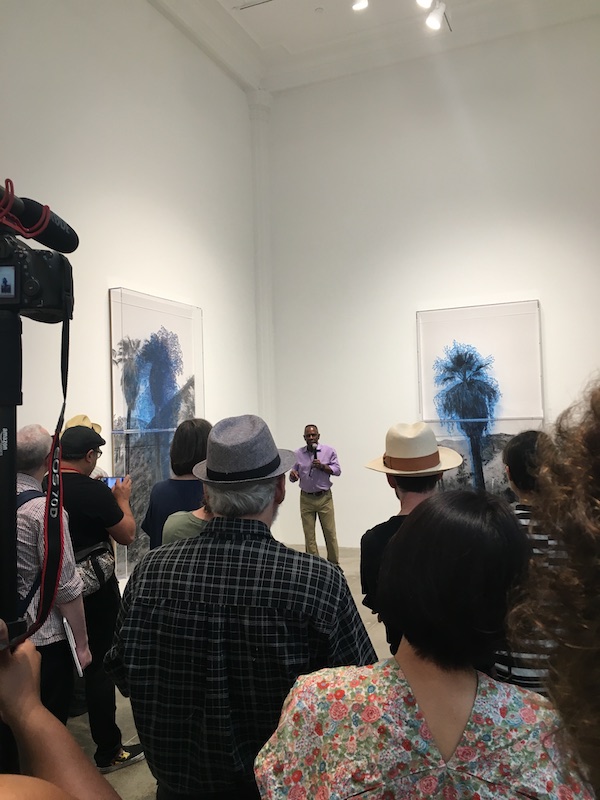
Charles Gaines at the press preview for Palm Trees and Other Works.
First, we experienced Charles Gaines’ exhibition, Palm Trees and Other Works, which debuted new works from his signature Gridworks series. We all gathered in the South Gallery to view the exhibition, which was accompanied by a talk with the artist himself. The noted American artist and educator bestowed details in regards to his process. Much like Sol LeWitt, Gaines incorporates systems and symbols in a method of visual language. I was intrigued by the works featuring black and white photographs of native trees from Palm Canyon, which existed under sheets of colorfully painted gridded squares on acrylic. Gaines explained that he then formulaically assigns each tree a color and plots numbers within a gridded framework. Utilizing specific colors along the way, the pieces manifest in strategic visual understanding, resulting in an array of colorful, seemingly pixilated landscapes.
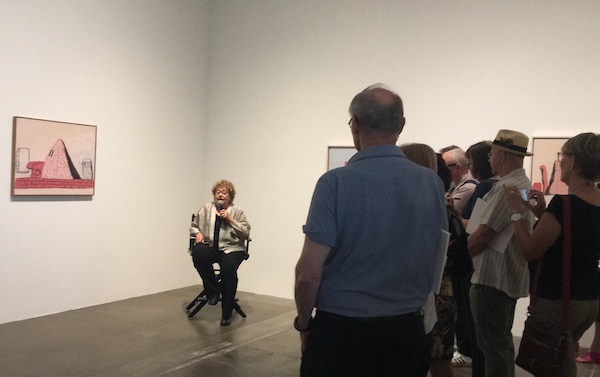
Musa Mayer, at press preview for Resilience: Philip Guston in 1971.
Next, we stopped by the North A and B Galleries that showcased, Resilience: Philip Guston in 1971. This exhibition curated by the artist’s daughter, Musa Mayer was the first solo Los Angeles exhibition in over half a century dedicated to Philip Guston. On view were the Roma paintings and the Nixon drawings, accompanied by a select group of larger works as well as a film featuring footage of the artist. The exhibition focused on 1971: one of the most inventive years of Guston’s practice despite his numerous rejections. Already familiar with the artists’ work, I was intrigued to learn more as Musa so eloquently recalled personal reflection in regards to her father’s practice. Mayer explained that Guston’s signature, flesh tone paintings and works on paper, now so familiar and celebrated, came through a time of deep criticism. She noted that these works were a result of him leaving the New York art scene and experiencing deep despair and isolation. Mayer notes she now realizes how fearless her father was to produce and explore work that mattered to him, despite the initial response. Like many prolific artists, Guston’s unfaltering boldness often led to criticism. Mayer reasoned, “He was an artists’ artist. He had a willingness to change rather than repeat what he was praised for.” Wandering through the exhibition and absorbing his daughter’s words, I was so glad he did.
After the press preview, we reflected on the talks and exhibitions over a spread of pastries, berries, yogurt, and coffee, complimentary of one of my favorite downtown spots, in Hauser & Wirth’s courtyard, Manuela.
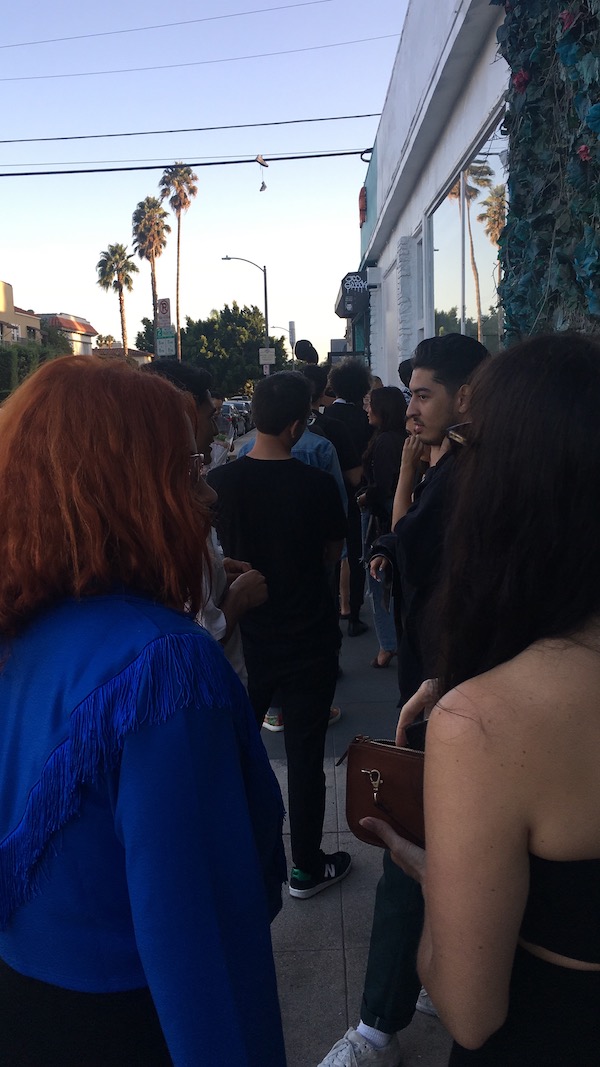
The line outside of HVW8.
Later that same evening we switched gears and headed to the group exhibition at HVW8 gallery, Thoughts Become Words, Words Become Images. Luckily, the lovely DJ Dana Boulos is a good friend and recommended we come early to beat the crowd. Although I knew little of the exhibition or space, I looked forward to the tunes by Boulos, so we made our way to the opening fashionably “on time.” Pulling up to the gallery, we were thankful we did since at 6:15 there was already a line. We hopped in amongst the other fashionable early birds and eagerly anticipated entry.
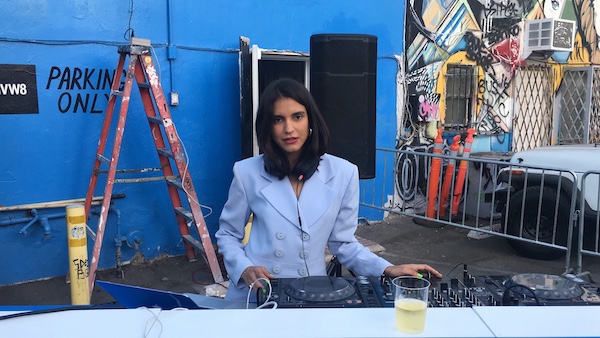
DJ Dana Boulos at HVW8.
The group show was composed of established artists Dev Hynes and Gia Coppola, as well as up-and-coming talents: musician Kelsey Lu, photographers Amanda Charchian and Lily Gavin, as well as the painter Cassi Namoda. The exhibition drew a hip crowd all who enjoyed the exhibition and the outdoor space where beverages included some refreshing wines by Gia Coppola. The gallery was pretty packed right when we entered, so I took a quick lay of the land, knowing I would come back in. We headed outside for some rosé to allow for the crowd inside to dissipate, so I could fully take in the work. Outside, I was lucky enough to have a moment with the curator, Anaïs Ngbanzo who graciously took some time to tell me that while organizing the show she prompted the artists to create work focusing on a specific piece of literary inspiration.
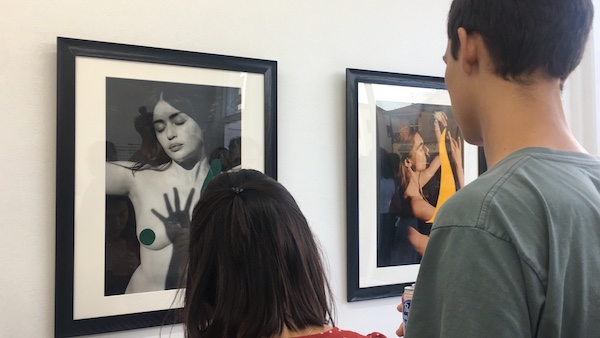
Viewers observing Amanda Charchian’s photographs, inspired by Patrick Süskind’s Perfume: The Story of a Murderer.
As we are a visually obsessed culture, I found it refreshing that Ngbanzo encouraged artists to rely on the mental imagery of words to inform their visual manifestations. The resulting show was a cohesive display of artistic mediums featuring photographs, paintings, and short films. Each artist celebrated the written narrative in his or her own unique marriage of image and word. The festivities abided into the warm evening as the crowd migrated to the lot outside where gallery exhibition turned into a dance party—a piece of art in and of itself.

